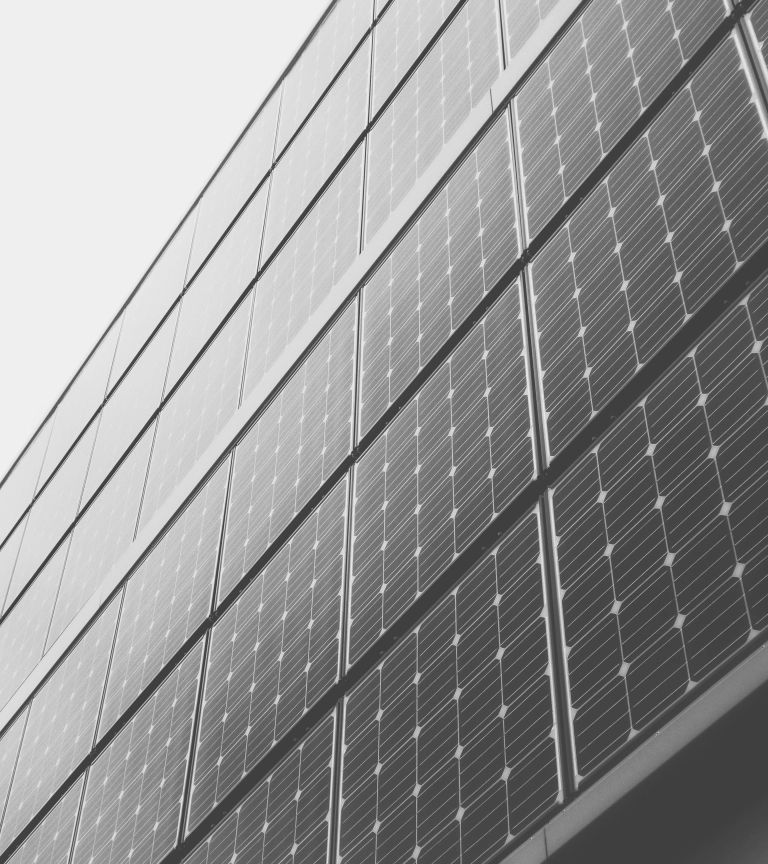
Photovoltaic systems
Sustainable solar electricity for a more independent energy supply
Self-generated solar-powered electricity
Photovoltaic systems are more than just the latest trend: installing a PV system on your roof reduces your exposure to rising electricity prices – and contributes to the energy transition.
Photovoltaics are key to the future
Solar energy is gaining ground. In times of rising electricity prices and a renunciation of fossil fuels, demand for sustainable, cost-effective energy generation methods is higher than ever. Photovoltaics are the most straightforward solution on the market. Installing fixed solar modules on your roof enables you to generate environmentally friendly electricity for your household – and, when coupled with a suitable photovoltaic storage system, you can even use solar-powered electricity in the evenings and overnight.
Would you like to learn more about our solar modules?
You can find everything you need to know about SENEC solar modules on our product page.
Why installing a photovoltaic system on your roof is worthwhile
Watch our video to discover why having a solar power system on your roof makes sense and key aspects you should bear in mind.

How does a PV system work?
A photovoltaic system converts sunlight into electric current. Its design relies on the photoelectric effect. A solar module is made up of lots of solar cells, which are in turn composed of numerous layers of semiconductors. When sunlight hits these solar cells, electrons are released from the semiconductor layers. A potential difference (voltage) appears between the layers and can be drawn up via contacts as direct current (DC). The drawn current is then transported indoors via a power cable, where it is subsequently converted to alternating current (AC).

Direct current vs. alternating current
Photovoltaic systems generate direct current (DC) but households run on alternating current (AC). Your solar-powered electricity therefore needs to be converted to alternating current before you can use it. This conversion is performed by an inverter, which you will need to supplement your PV system. If you install your solar power system in combination with a battery energy storage system, you may be able to avoid purchasing a separate inverter as some storage devices come with integrated inverters.
Components of a photovoltaic system
A solar power system is made up of numerous modules that connect lots of individual solar cells . Photovoltaic technology is special because it uses freely available solar energy – but that’s not all. It also generates electricity without any components having to rotate or move. As a result, solar energy is an ideal solution for the self-supply of electricity. All you need to do is install the PV modules on the roof and you’re ready to go. No disruptive vibrations and no wearing parts that require regular maintenance. PV modules are fitted to roofs using mounting systems . If a house is being newly built, or if a roof is being refurbished, it is also possible to integrate PV systems into the roof cladding . This is a more aesthetically attractive solution – but it does reduce the system’s performance as it makes it more difficult to cool the modules. The electricity from the PV system is transported from the roof via cables and into the house distribution board, where it can be used directly, stored for later use or fed into the grid.
How large should my photovoltaic system be?
When it comes to calculating the size of your solar power system, there are two main factors to consider:
- the available roof area
- your personal electricity consumption
As a rule of thumb, and depending on the module type and capacity, we can say that solar modules covering 10 m² will have a rating of around 1 kilowatt-peak (kWp) and generate around 1,000 kWh per year. Ideally, the electricity produced by your solar power system should at least cover your annual electricity requirements. You can find out how much electricity you use each year by looking at your annual utility statements for recent years.
Example calculation
Four-person household
Annual electricity consumption: 5,000 kWh
Electricity consumption of 5,000 kWh = PV system with 5 kWp capacity = 50 m² of solar modules
Four-person household with a heat pump and EV
Annual electricity consumption: approx. 12,000 kWh
Electricity consumption of 12,000 kWh = PV system with 12 kWp capacity = 120 m² of solar modules
If you have enough roof area available, you should plan your solar power system with the future in mind. Due to the rise of e-mobility and heat pumps, average electricity requirements are rising rather than falling. It is therefore worthwhile planning a photovoltaic system somewhat larger than you currently need – so that you can charge your electric car with solar electricity at home in the future, for example.
Make sure your PV system matches your needs
Our experts would be happy to advise you, free of charge
Installing a solar power system on your roof
Before the photovoltaic system can be installed on your roof, your SENEC specialist partner will inspect your property and provide detailed advice. This ensures that all questions are cleared up in advance, such as:
- Will the solar modules be fitted to the roof directly or mounted on a substructure?
- Where should the cables run from the roof into the house?
- How many solar modules do you need?
- What should your solar modules look like?
- Do you want to install any further PV system components, such as a battery energy storage system?
Experienced roofers will take care of the installation. Many specialist solar energy companies employ their own in-house roofers. It takes around two days to install a solar power system. You should try to be at home for this period, or at the very least remain contactable.
Structural requirements for a solar power system
Roof orientation
South-facing roofs offer the highest electricity yields because solar energy is highest around noon, when the sun is in the south. Roofs facing south-west or south-east offer similarly high yields. In the case of houses with east-west-facing roofs , solar electricity generation is spread evenly over the day – which is ideal if you mainly intend to use your self-generated electricity yourself. North-facing roofs are not suitable for solar power systems.
Roof pitch
The pitch of your roof also has an impact on electricity yields. In principle, however, solar power systems can be installed on roofs of any pitch. Your experienced SENEC specialist partner will orientate the solar modules on your roof to optimise their output. Even on flat roofs, solar modules can be installed on a substructure to achieve the best possible angle of inclination.
Roof types and materials
Almost all common roof types and roofing materials are suitable for solar module installation. The only exceptions are thatched roofs, wooden roofs and other natural materials. Your SENEC specialist partner will carefully inspect your roof and determine whether a substructure is necessary, how much space is available on the roof, and whether the area available is restricted by dormers, chimneys or other elements.
Three tips for planning your photovoltaic system
Even before your consultation meeting, your specialist partner will be able to clarify many of the main points with you to determine whether your roof might be suitable for a photovoltaic system.
- Required roof area: A 1 kW photovoltaic system usually requires around 5–6 m² of roof area. You can therefore calculate the required roof area based on your daily electricity requirements.
- Shade: If at all possible, the roof area should not be in any kind of shade, such as from tall trees or neighbouring buildings. When planning your system, remember that trees will be in full leaf in summer and cast significantly more shade.
- Check the solar land register: Many municipalities and cities now maintain solar land registers, which you can access online. This provides a useful initial impression of whether your house would be suitable for a solar power system.

Do I need planning permission for a PV system?
In most cases, solar power systems do not require planning permission. This is especially true when solar modules are installed parallel to your roof: although their installation is considered a construction measure, it does not usually require any permit or permission. Listed buildings are an exception to this. and require prior permission for any photovoltaic system. In addition, individual municipalities can set out their own regulations in development plans, such as preventing changes to the character of a street. The best thing to do is ask your local authorities about any relevant building regulations before you start planning your PV system.
Solar power systems and photovoltaic systems – what’s the difference?
The terms “solar power system” and “photovoltaic system” are often used interchangeably – but there is a difference. A solar power system is any kind of system than converts solar energy into another form of energy. This includes photovoltaic systems, which feature solar cells that convert sunlight into electricity. Other forms of solar installation include solar thermal systems. These systems comprise solar collectors, which heat water that can then be used in households. Solar thermal systems convert sunlight into heat rather than electricity. However, if you opt for a photovoltaic system, that is not to say you have to miss out on a solar power-based hot water system. You could install a heat pump or a heating element for your boiler to use your solar-powered electricity to provide hot water.
Tips for buying a solar power system
Have you already decided on a PV system? Watch our video to learn what the preparation, planning and implementation phases involve.

Checklist for planning your PV system
- Roof shape and roofing material: All roof types are suitable for PV systems, with the exception of thatched, grass and wooden roofs.
- Roof pitch: Flat roofs and certain monopitch roofs require a subconstruction for the solar modules
- Orientation: Only north-facing roofs are unsuitable for PV systems
- Available roof area: How many m² of roof space are available? Does your roof have any skylights, chimneys or other features that reduce the available area?
- Electricity needs: What is your annual electricity consumption? What capacity does your PV system need to have?
- Local building regulations: Does your local building code have any specific regulations or requirements? Is your house listed?
- Weather conditions: Is your roof particularly exposed to wind? Is your region prone to extreme weather conditions?
- Aesthetics: Is the colour or design of the solar modules important to you?
- Guarantee: Does the system come with a product warranty and a performance guarantee? Who provides this guarantee – and are you confident they will still be in business in 20 years?
Does a PV system make financial sense?
The price of photovoltaic systems has fallen dramatically over recent years. Solar electricity is now the most affordable way to generate electricity, even if installing a solar power system still involves an up-front investment. In the long term, however, a solar power system is financially worthwhile based on rising electricity prices alone, as well as the general increase in electricity demand. If you generate your own solar electricity, you will have to buy less of the expensive electricity from the grid.
Benefit from solar electricity all year round with a PV system and PV storage system
Many people have concerns as to whether a solar power system is a worthwhile investment in the German climate, with few hours of sunlight compared to some countries. However, as the energy transition has progressed, there have also been major advances in solar technology. Modern photovoltaic modules deliver excellent performance even in poor light conditions, so they still generate electricity under cloudy skies. You can also connect your photovoltaic system to a PV storage system. This stores the solar-powered electricity you are unable to use straight away, enabling you to use your self-generated energy in the evenings or in poor weather conditions.
Arrange a free consultation
Find the optimal photovoltaic solution for your requirements.
How much does a photovoltaic system cost?
The high demand for renewable energy has not only led to solar power systems becoming more powerful but has also driven down their price, making them more affordable. Investing in your own photovoltaic system has never been as easy – yet every system needs to be customised and planned with location-specific conditions in mind. As a result, it is not possible to provide a universally applicable flat price. SENEC places particular emphasis on providing extensive consultations and putting together an offer tailored to your needs – without any surprises or hidden costs.
Photovoltaic systems, VAT and income tax
From the perspective of German tax law, purchasing and installing your own photovoltaic system turns you into a small business owner. For this reason, you must pay value-added tax (VAT) on solar electricity – not only the electricity you feed into the public grid and for which you receive compensation from the grid operator, but also for the electricity you generate for your own consumption. This means that you need to file a VAT return once per year and submit a monthly preliminary VAT return for the first two years. In addition, your income from the electricity you sell – that is, income via the feed-in tariff – is subject to income tax. In practice, this means that you must register a trade with your local authority and record your income from the sale of electricity as commercial income in your income tax declaration.
Small business regulation for solar power systems
If you formally register your installation as a small business (Kleinunternehmen) rather than a trade (Gewerbe), you will not have to pay VAT on your solar electricity. However, you would then be unable to reclaim any VAT paid on the planning, purchase and installation of your PV system from the tax authorities. A new system comprising photovoltaic modules and an energy storage system is a considerable undertaking from a tax perspective. You also have the option of initially registering a trade (Gewerbe) with the tax authorities and then switching to small business (Kleinunternehmer) status after six years without having to repay anything. A tax advisor can help you to weigh up your options and find the most tax-efficient route for you.